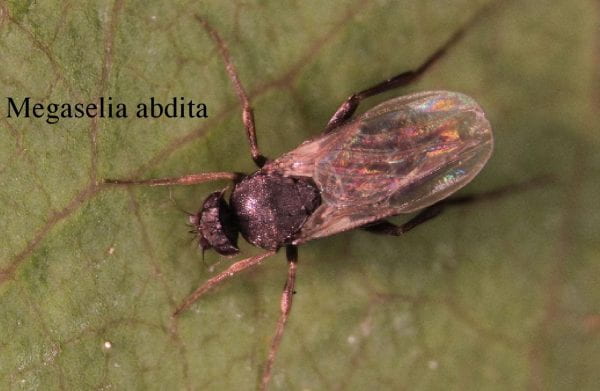Megaselia abdita (M. griseipennis)
The humpbacked fly Megaselia abdita is a perfect lab animal. The species is common in North America and Europe and is easy to keep in the laboratory. It represents the Phoroidea lineage and split very early from other Cyclorrhapha. The generation time of Megaselia abdita is about 3 weeks at 25 C. Besides its value as a model in evolutionary developmental biology, the species is used in forensic biology.


Protocols, Resources, and Staging
- The scuttle fly Megaselia abdita (Phoridae): a link between Drosophila and Mosquito development. Rafiqi AM, Lemke S, Schmidt-Ott U. Cold Spring Harbor Protocols. 2011; 2011(4):pdb.emo143. PMID:21460041
- Megaselia abdita: culturing and egg collection. Rafiqi AM, Lemke S, Schmidt-Ott U. Cold Spring Harbor Protocols. 2011; 2011(4):pdb.prot5600. PMID:21460049
- Megaselia abdita: preparing embryos for injection. Rafiqi AM, Lemke S, Schmidt-Ott U. Cold Spring Harbor Protocols. 2011; 2011(4):pdb.prot5601. PMID:21460050
- Megaselia abdita: fixing and devitellinizing embryos. Rafiqi AM, Lemke S, Schmidt-Ott U. Cold Spring Harbor Protocols. 2011; 2011(4):pdb.prot5602. PMID:21460051
- Megaselia abdita: cuticle preparation from injected embryos. Rafiqi AM, Lemke S, Schmidt-Ott U. Cold Spring Harbor Protocols. 2011; 2011(4):pdb.prot5603. PMID:21460052
- High-resolution gene expression data from blastoderm embryos of the scuttle fly Megaselia abdita. Wotton KR, Jiménez-Guri E, Crombach A, Cicin-Sain D, Jaeger J. Sci Data. 2015 Mar 3;2:150005. doi: 10.1038/sdata.2015.5. eCollection 2015. PMID: 25977812
- Heterochronic shifts in germband movements contribute to the rapid embryonic development of the coffin fly Megaselia scalaris. Wotton KR. Arthropod Struct Dev. 2014 Nov;43(6):589-94. doi: 10.1016/j.asd.2014.08.001. Epub 2014 Sep 2. PMID:25193503
- A staging scheme for the development of the scuttle fly Megaselia abdita. Wotton KR, Jiménez-Guri E, García Matheu B, Jaeger J. PLoS One. 2014 Jan 7;9(1):e84421. doi: 10.1371/journal.pone.0084421. eCollection 2014. PMID:24409295
- Comparative transcriptomics of early dipteran development. Jiménez-Guri E, Huerta-Cepas J, Cozzuto L, Wotton KR, Kang H, Himmelbauer H, Roma G, Gabaldón T, Jaeger J. BMC Genomics. 2013 Feb 24;14:123. doi: 10.1186/1471-2164-14-123. PMID:23432914
- Germ line transformation and in vivo labeling of nuclei in Diptera: report on Megaselia abdita (Phoridae) and Chironomus riparius (Chironomidae). Caroti F, Urbansky S, Wosch M, Lemke S. Dev Genes Evol. 2015 Jun;225(3):179-86. doi: 10.1007/s00427-015-0504-5. Epub 2015 Jun 5. PMID: 26044750
- Megaselia abdita Schmitz, 1959 (Diptera, phoridae): proposed precedence over Aphiochaeta griseipennis Santos Abreu, 1921 (currently Megaselia griseipennis). Disney RH, Akam M, Simpson P, Schmidt-Ott U. The Bulletin of Zoological Nomenclature 67(3):238-242 (2010).
1 September 2010. Case 3521
https://doi.org/10.21805/bzn.v67i3.a1
Selected Publications
- Decoupling from yolk sac is required for extraembryonic tissue spreading in the scuttle fly Megaselia abdita. Caroti F, González Avalos E, Noeske V, González Avalos P, Kromm D, Wosch M, Schütz L, Hufnagel L, Lemke S. Elife. 2018 Oct 30;7. pii: e34616. doi: 10.7554/eLife.34616. PMID:30375972
- Two consecutive microtubule-based epithelial seaming events mediate dorsal closure in the scuttle fly Megaselia abdita. Fraire-Zamora JJ, Jaeger J, Solon J. Elife. 2018 Mar 14;7. pii: e33807. doi: 10.7554/eLife.33807. PMID: 29537962
- Functional evolution of a morphogenetic gradient. Kwan CW, Gavin-Smyth J, Ferguson EL, Schmidt-Ott U. eLife. 2016; 5.PMID:28005004, PMCID:PMC5224919
- Quantitative system drift compensates for altered maternal inputs to the gap gene network of the scuttle fly Megaselia abdita. Wotton KR, Jiménez-Guri E, Crombach A, Janssens H, Alcaine-Colet A, Lemke S, Schmidt-Ott U, Jaeger J. eLife. 2015; 4. PMID:25560971, PMCID:PMC4337606
- BMP-dependent serosa and amnion specification in the scuttle fly Megaselia abdita. Rafiqi AM, Park CH, Kwan CW, Lemke S, Schmidt-Ott U. Development. 2012; 139(18):3373-82. PMID:27399647
- Evolutionary origin of the amnioserosa in cyclorrhaphan flies correlates with spatial and temporal expression changes of zen. Rafiqi AM, Lemke S, Ferguson S, Stauber M, Schmidt-Ott U. Proceedings of the National Academy of Sciences of the United States of America. 2008; 105(1):234-9.
PMID:18172205, PMCID:PMC2224192 - Postgastrular zen expression is required to develop distinct amniotic and serosal epithelia in the scuttle fly Megaselia. Rafiqi AM, Lemke S, Schmidt-Ott U. Developmental Biology. 2010; 341(1):282-90. PMID:20144604
- Bicoid occurrence and Bicoid-dependent hunchback regulation in lower cyclorrhaphan flies. Lemke S, Stauber M, Shaw PJ, Rafiqi AM, Prell A, Schmidt-Ott U. Evolution & Development. 2008; 10(4):413-20. PMID:18638318
- Expression and regulation of caudal in the lower cyclorrhaphan fly Megaselia. Stauber M, Lemke S, Schmidt-Ott U. Development Genes and Evolution. 2008; 218(2):81-7. PMID:18214532, PMCID:PMC2757626
- Evolutionary origin of the amnioserosa in cyclorrhaphan flies correlates with spatial and temporal expression changes of zen. Rafiqi AM, Lemke S, Ferguson S, Stauber M, Schmidt-Ott U. Proceedings of the National Academy of Sciences of the United States of America. 2008; 105(1):234-9. PMID:18172205, PMCID:PMC2224192
- A single Hox3 gene with composite bicoid and zerknullt expression characteristics in non-Cyclorrhaphan flies. Stauber M, Prell A, Schmidt-Ott U. Proceedings of the National Academy of Sciences of the United States of America. 2002; 99(1):274-9. PMID:11773616, PMCID:PMC117551
- Function of bicoid and hunchback homologs in the basal cyclorrhaphan fly Megaselia (Phoridae). Stauber M, Taubert H, Schmidt-Ott U. Proceedings of the National Academy of Sciences of the United States of America. 2000; 97(20):10844-9. PMID:10995461, PMCID:PMC27111
- The anterior determinant bicoid of Drosophila is a derived Hox class 3 gene. Stauber M, Jäckle H, Schmidt-Ott U. Proceedings of the National Academy of Sciences of the United States of America. 1999; 96(7):3786-9. PMID:10097115, PMCID:PMC22372
- Expression of engrailed in embryos of a beetle and five dipteran species with special reference to the terminal regions. Schmidt-Ott U, Sander K, Technau GM. Roux’s Archives of Developmental Biology. 1994; 203(6):298-303. PMID:28305822
